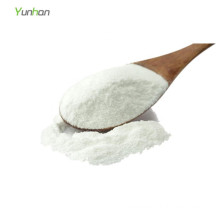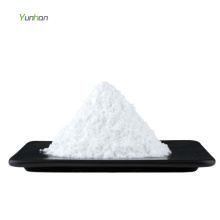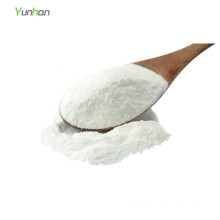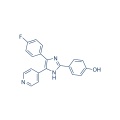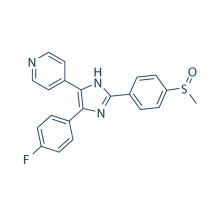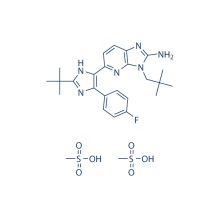SB202190 (FHPI) 152121-30-7
Product Description
.cp_wz table {border-top: 1px solid #ccc;border-left:1px solid #ccc; } .cp_wz table td{border-right: 1px solid #ccc; border-bottom: 1px solid #ccc; padding: 5px 0px 0px 5px;} .cp_wz table th {border-right: 1px solid #ccc;border-bottom: 1px solid #ccc; padding: 5px 0px 0px 5px;}
Molecular Weight: 331.34 SB202190 (FHPI) is a potent p38 MAPK Inhibitor targeting p38α/β with IC50 of 50 nM/100 nM, sometimes used instead of SB 203580 to investigate potential roles for SAPK2a/p38 in vivo.
Biological Activity
SB 202190 significantly inhibits both basal and anti-Fas
antibody-induced MAPKAPK 2 activity in a dose-dependent manner. SB202190
by itself is sufficient to induce cell death in Jurkat and HeLa cells
through activation of CPP32-like caspases, which can be blocked by
expression of bcl-2. SB202190-induced Apoptosis is attenuated by p38β
but augmented by p38α. [SB 202190 strongly inhibits UVB
induced COX-2 protein expression in HaCaT cells, and markedly inhibits
UVB induced cox-2 mRNA. SB 202190 treatment inhibits the expression of
albumin-induced proinflammatory (monocyte chemoattractant protein-1) and
transforming growth factor (TGF)-beta1-induced profibrotic
(procollagen-Ialpha1) genes over 50% in renal tubular cells (normal rat
kidney-52E).
SB 202190 treatment induces phosphorylation of JNK in a
dose- and time- dependent manner in A549 cells, induces phosphorylation
of ATF-2 transcription factor, and increases AP-1 DNA binding. SB
202190 treatment enhances the growth of THP-1 and MV4-11 cells. SB
202190 increases the phosphorylation of c-Raf and ERK, suggesting that
Ras-Raf-MEK-mitogen-activated protein kinase (MAPK) pathway activation
is involved in the leukemia cell growth induced by SB 202190.
Inhibiting p38 by administration of SB 202190 inhibits PV IgG-induced
blister formation in the passive transfer mouse model. In the endotoxin
model of sepsis, SB 202190 treatment produces a statistically
significant survival benefit compared with control.
Protocol(Only for Reference)
Kinase Assay: [1]
Cell Assay: [2]
Animal Study: [5]
Conversion of different model animals based on BSA (Value based on data from FDA Draft Guidelines)
For example, to modify the dose of resveratrol used for a mouse (22.4 mg/kg) to a dose based on the BSA for a rat, multiply 22.4 mg/kg by the Km factor for a mouse and then divide by the Km factor for a rat. This calculation results in a rat equivalent dose for resveratrol of 11.2 mg/kg.
Chemical Information
Molarity Calculator
Dilution Calculator
Molecular Weight Calculator
Contact us if you need more details on 152121-30-7. We are ready to answer your questions on packaging, logistics, certification or any other aspects about SB202190 152121-30-7、FHPI 152121-30-7. If these products fail to match your need, please contact us and we would like to provide relevant information.
Molecular Weight: 331.34 SB202190 (FHPI) is a potent p38 MAPK Inhibitor targeting p38α/β with IC50 of 50 nM/100 nM, sometimes used instead of SB 203580 to investigate potential roles for SAPK2a/p38 in vivo.
Biological Activity
SB 202190 significantly inhibits both basal and anti-Fas
antibody-induced MAPKAPK 2 activity in a dose-dependent manner. SB202190
by itself is sufficient to induce cell death in Jurkat and HeLa cells
through activation of CPP32-like caspases, which can be blocked by
expression of bcl-2. SB202190-induced Apoptosis is attenuated by p38β
but augmented by p38α. [SB 202190 strongly inhibits UVB
induced COX-2 protein expression in HaCaT cells, and markedly inhibits
UVB induced cox-2 mRNA. SB 202190 treatment inhibits the expression of
albumin-induced proinflammatory (monocyte chemoattractant protein-1) and
transforming growth factor (TGF)-beta1-induced profibrotic
(procollagen-Ialpha1) genes over 50% in renal tubular cells (normal rat
kidney-52E).
SB 202190 treatment induces phosphorylation of JNK in a
dose- and time- dependent manner in A549 cells, induces phosphorylation
of ATF-2 transcription factor, and increases AP-1 DNA binding. SB
202190 treatment enhances the growth of THP-1 and MV4-11 cells. SB
202190 increases the phosphorylation of c-Raf and ERK, suggesting that
Ras-Raf-MEK-mitogen-activated protein kinase (MAPK) pathway activation
is involved in the leukemia cell growth induced by SB 202190.
Inhibiting p38 by administration of SB 202190 inhibits PV IgG-induced
blister formation in the passive transfer mouse model. In the endotoxin
model of sepsis, SB 202190 treatment produces a statistically
significant survival benefit compared with control.
Protocol(Only for Reference)
Kinase Assay: [1]
| In vitro kinase assays | The p38α and p38β are assayed in 25 mM Tris-HCl, pH 7.5, containing 0.1 mM EGTA, with myelin basic protein (0.33 mg/mL) as substrate. Assays are performed either manually for 10 minutes at 30 °C in 50 μL incubations using [γ-33P]ATP, or with a Biomek 2000 Laboratory Automation Workstation in a 96-well format for 40 minutes at ambient temperature in 25 μL incubations using [γ-33P]ATP. The concentrations of ATP and magnesium acetate are 0.1 mM and 10 mM respectively. All assays are initiated with MgATP. Manual assays are terminated by spotting aliquots of incubation on to phosphocellulose paper, followed by immersion in 50 mM phosphoric acid. Robotic assays are terminated by the addition of 5 μL of 0.5 M phosphoric acid before spotting aliquots on to P30 filter mats. All papers are then washed four times in 50 mM phosphoric acid to remove ATP, once in acetone (manual incubations) or methanol (robotic incubations), and then dried and counted for radioactivity. |
|---|
Cell Assay: [2]
| Cell lines | Jurkat, and HeLa |
|---|---|
| Concentrations | Dissolved in DMSO, final concentrations ~50 μM |
| Incubation Time | 24 hours |
| Method | Cells are serum-starved and then treated with different concentration of SB 202190 for 24 hours. Cell viability is assayed by either trypan blue exclusion or propidium iodide exclusion followed by flow cytometry analysis. The apoptotic nuclei are visualized by H33258 staining. |
Animal Study: [5]
| Animal Models | C57BL/6J mice injected i.d. with a sterile solution of either control IgG or PV IgG | ||
|---|---|---|---|
| Formulation | Dissolved in DMSO, and diluted in saline | ||
| Dosages | 12.5 μg | ||
| Administration | Administered via i.d. | ||
| Solubility | 1% DMSO/30% polyethylene glycol/1% Tween 80, 30 mg/mL | ||
| * Please note that Selleck tests the solubility of all compounds in-house, and the actual solubility may differ slightly from published values. This is normal and is due to slight batch-to-batch variations. | |||
Conversion of different model animals based on BSA (Value based on data from FDA Draft Guidelines)
| Species | Baboon | Dog | Monkey | Rabbit | Guinea pig | Rat | Hamster | Mouse |
| Weight (kg) | 12 | 10 | 3 | 1.8 | 0.4 | 0.15 | 0.08 | 0.02 |
| Body Surface Area (m2) | 0.6 | 0.5 | 0.24 | 0.15 | 0.05 | 0.025 | 0.02 | 0.007 |
| Km factor | 20 | 20 | 12 | 12 | 8 | 6 | 5 | 3 |
| Animal A (mg/kg) = Animal B (mg/kg) multiplied by | Animal B Km |
| Animal A Km |
For example, to modify the dose of resveratrol used for a mouse (22.4 mg/kg) to a dose based on the BSA for a rat, multiply 22.4 mg/kg by the Km factor for a mouse and then divide by the Km factor for a rat. This calculation results in a rat equivalent dose for resveratrol of 11.2 mg/kg.
| Rat dose (mg/kg) = mouse dose (22.4 mg/kg) × | mouse Km(3) | = 11.2 mg/kg |
| rat Km(6) |
Chemical Information
| Molecular Weight (MW) | 331.34 |
|---|---|
| Formula | C20H14N3OF |
| CAS No. | 152121-30-7 |
| Storage | 3 years -20℃Powder |
|---|---|
| 6 months-80℃in solvent (DMSO, water, etc.) | |
| Synonyms | |
| Solubility (25°C) * | In vitro | DMSO | 66 mg/mL (199.19 mM) |
|---|---|---|---|
| Water | <1 mg/mL ( | ||
| Ethanol | 12 mg/mL (36.21 mM) | ||
| In vivo | 1% DMSO/30% polyethylene glycol/1% Tween 80 | 30 mg/mL | |
| * <1 mg/ml means slightly soluble or insoluble. * Please note that Selleck tests the solubility of all compounds in-house, and the actual solubility may differ slightly from published values. This is normal and is due to slight batch-to-batch variations. | |||
| Chemical Name | 4-(4-(4-fluorophenyl)-5-(pyridin-4-yl)-1H-imidazol-2-yl)phenol |
|---|
Molarity Calculator
Dilution Calculator
Molecular Weight Calculator
Contact us if you need more details on 152121-30-7. We are ready to answer your questions on packaging, logistics, certification or any other aspects about SB202190 152121-30-7、FHPI 152121-30-7. If these products fail to match your need, please contact us and we would like to provide relevant information.
Product Categories : MAPK > p38 MAPK Inhibitor
Other Products
Hot Products
Astragaloside AChlortetracycline HCl 64-72-2Paclitaxel 33069-62-4Dexamethasone Acetate 1177-87-3Dinaciclib (SCH727965) 779353-01-4CHIR-124 405168-58-3Ro3280 1062243-51-9TAME 901-47-3CCG-1423 285986-88-110058-F4 403811-55-2Dabigatran (BIBR 953) 211914-51-1H 89 2HCl 130964-39-5T0901317 293754-55-9Aprepitant 170729-80-3Turofexorate Isopropyl (XL335) 629664-81-9BMS-378806 357263-13-9
